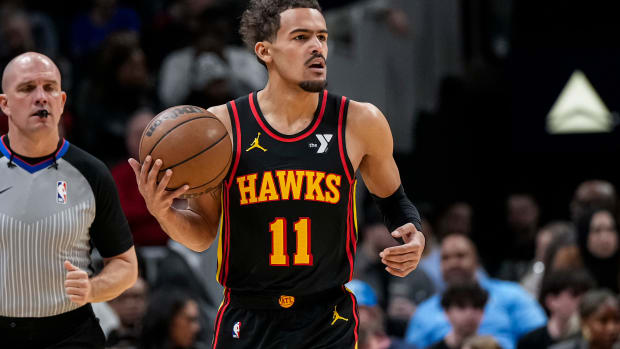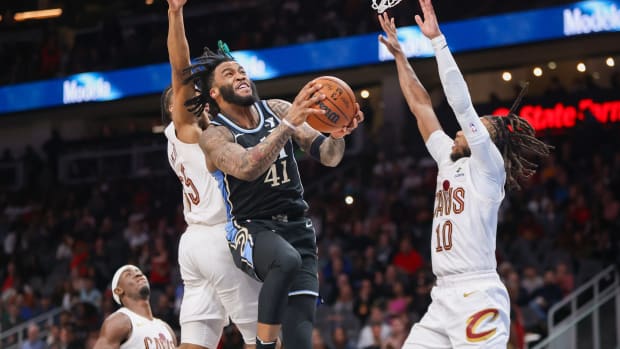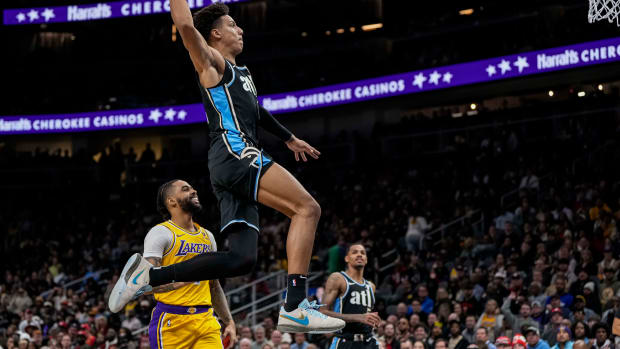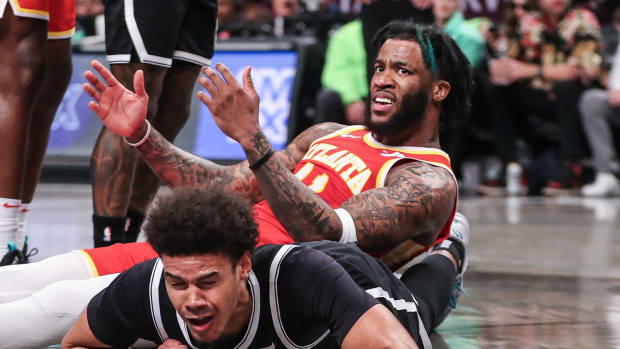News and Notes From Hawks Practice
The Hawks returned to the practice court on Wednesday afternoon after the All-Star break, appearing refreshed and clear-eyed as they enter the home stretch of the NBA season. At 15-41 with just 26 games remaining on the schedule, Atlanta has no delusions of challenging for a playoff spot, but won't roll over like many bad teams do in the final months of the season, either.
The next six weeks will provide an opportunity to evaluate and develop the team's young core, as well as how its new additions from the trade deadline fit in, and both the players and coaching staff intend to maximize the time remaining in the season.
Here are a few of the notable plot lines to follow over the next 26 games:
Injuries
Every NBA team must navigate injuries over the course of a season and few squads are fully healthy this time of year, but the Hawks have been afflicted with a particularly poor run of health this season. Lloyd Pierce hasn't had a full rotation at his disposal since December, and Atlanta's biggest acquisition at the trade deadline has yet to suit up in a Hawks uniform.
Clint Capela has missed eight of his last nine games -- dating back to his time in Houston -- with plantar fasciitis in his right heel, and Pierce said on Wednesday that both Capela and Skal Labissière are likely "weeks away" from seeing any game time. Both big men participated in light on-court work after Wednesday's practice. Labissière mostly worked on mid-range jumpers while Capela dribbled a weighted ball and tossed short hook shots through the rim. Both are also "continuing non-impact conditioning and strength work," according to a team release, but aren't close to taking contact and playing against NBA competition.
That could both complicate and clarify the next few weeks for the Hawks. On the one hand, they won't get the data they want on how Capela fits with the rest of the team's young core, but it also allows Atlanta to gather more information on its other young players, who will likely spend more time together in Capela's absence.
The Hawks have repeatedly emphasized that they won't rush Capela back to the court, and they are correct in being cautious. Still, the team would like to see how he looks next to Trae Young, Kevin Huerter, John Collins, Cam Reddish, and De'Andre Hunter.
The growth of the "core five"
With Clint Capela sidelined indefinitely, the fivesome of Young, Huerter, Reddish, Hunter, and Collins will log plenty of time with one another. That prospect excites Pierce, who has been encouraged by the early returns on that group. That small, young lineup has outscored opponents in over 250 possessions and been particularly effective on offense.
It seems abundantly clear that the franchise's primary focus through the rest of the season will be developing that group -- at least until Capela comes back. Pierce says he wants to play those five together as much as possible, and possibly increase the sample of data on them to 1000 possessions.
"The challenge is over 27 games, how do I get that to 1000 possessions or 800 possessions?" Pierce said. "Will it tell me everything? No, but you feel good about it."
After Wednesday's practice, Pierce met with his five young players to discuss how the group can grow together over the final 26 games of the year, how each player can unlock a better version of himself to finish the season, and how the five might better complement one another's strengths and cover for their weaknesses on the court.
"The excitement is that there are so many things that we’re capable of doing because of their skill sets and their ability on the court, that we’re going to have fun trying to explore some of those," he said. ""If we can continue to grow them individually, I think the total package will come together."
Possible offensive adjustments
One of the benefits Pierce hopes will stem from increased cohesion between Atlanta's core players is Young working away from the ball more often. The All Star ranks third in the NBA in catch-and-shoot 3-point percentage (minimum 50 attempts) at 47.6 percent, but has taken fewer than 100 such shots all season. Huerter shoots over 44 percent on catch-and-shoot triples, but even he has taken relatively few attempts. The challenge, then, is more regularly unlocking that part of Young's game via scripted play-calls, off-ball movement, and secondary creation from Huerter, Reddish, or Jeff Teague.
"Trae’s tremendous with the basketball in his hands, and he’s also [third] in the league in catch-and-shoot 3s [by percentage]," Pierce said. "How do you grow Cam? You put the ball in Cam’s hands. How do you grow Trae? You take him to an area where he’s already excelling at a tremendous rate."
Sparing Young some of the strain that comes with handling the ball as often as he has this year could not only keep him fresh on offense, but allow him to expend more energy on the other end of the floor (stop laughing). That possibility remains mostly theoretical -- Young is one of the worst defenders in the NBA -- but Pierce continues to emphasize the importance of that side of the ball and the potential for growth Young has there.
"It’s just conditioning your mind and your body to do more," Pierce said. "He ain’t gonna get any bigger, so get peskier, get nastier, you get a little more physical. So you get in shape mentally and physically to say ‘I’m gonna do a little bit more.’"
Another offensive wrinkle that we could see after the All-Star break: more guard-to-guard pick-and-rolls. Pierce turned to this tactic earlier in the season when Collins was suspended and the team was thin on big men, and has used Hunter as a screener fairly often all year. But more two-man actions between Young, Huerter, and Reddish could make Atlanta's offense more dynamic as they play smaller, quicker units.
Perhaps the most effective change the Hawks can make on offense is taking better care of the ball. Only the Cavaliers have turned the ball over more often than Atlanta this season, which has dragged down the Hawks' offense. Last season, they took better care of the ball during the home stretch of the season, and as a result had a league-average offense over their last 20 games. Pierce hopes for a similar kind of turnaround this season, and with it a boost in offensive and defensive efficiency.
"We had a team meeting today and just focused on one area: post-All star last year, we turned the ball over less, we became the 11th offensive rating team post-All Star," he said. "If we can cut those turnovers down, if we can share the basketball, if we can use our spacing a little bit better, our defense won’t take as much of a hit."
That, of course, is far easier said than done with an inexperienced, fast-paced team, but Atlanta has the capacity for improvement as its young ball-handlers develop their skill and decision-making.
None of these changes -- should they even come to fruition -- will have much bearing on this year's outcome. The Hawks fell into too deep of a hole during the first two months of the season to play any consequential games in the final two. But they must only play well enough to justify optimism for future seasons, and prove to themselves what they can be.
"It’s been tough, but obviously the next [26] games, we just remember back to last season how positively we finished the year," Huerter said. "As a team we want to put together a really good stretch here and finish the season… just keep trying to build positive energy."




